[ad_1]
Want to add fresh, flavorful cilantro to your meals? Learn how to grow cilantro at home with our easy-to-follow guide, including tips from selecting the best location to preventing cilantro from bolting.
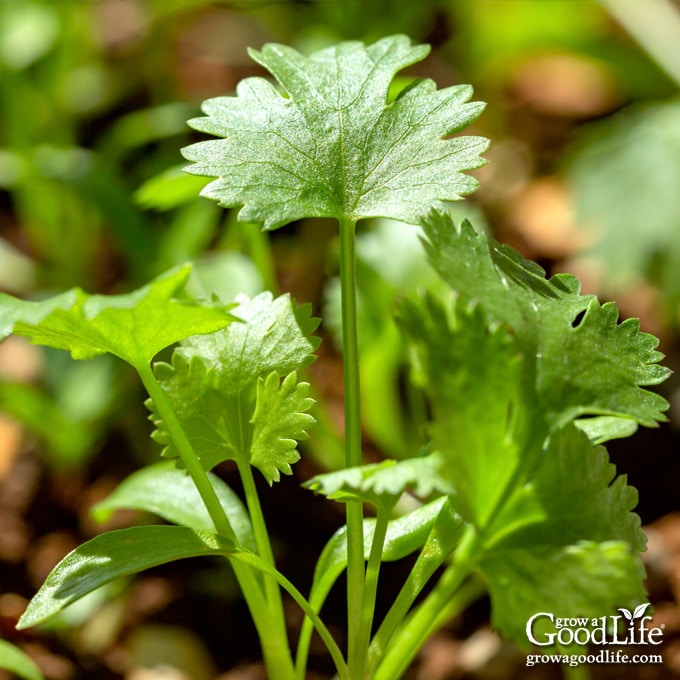
If you’re a fan of fresh and citrusy flavors, you’ll want to learn how to grow cilantro. Not only does it offer a delicious taste to your meals, but you also get two food products for the price of one – the leafy cilantro and the edible coriander seeds.
The flavor of cilantro foliage can be described as pungent and citrusy, with a slightly sweet and earthy undertone. Some people also detect a soapy or metallic taste, which is believed to be due to a genetic variation that makes them sensitive to certain compounds found in cilantro. Overall, the flavor of cilantro is unique and can add a fresh and bright note to salsa and Mexican foods.
Now, I know cilantro has a unique taste that not everyone is a fan of, but even if you’re not crazy about the flavor, cilantro is still a great addition to your garden. It has beautiful foliage resembling delicate ferns and can help keep pests at bay while attracting beneficial insects to your garden.
And let’s not forget about the coriander seeds. These little gems have a completely different flavor and can be used as a spice in various dishes, like pickles, chili con carne, and other seasoning mixes. Talk about versatility!
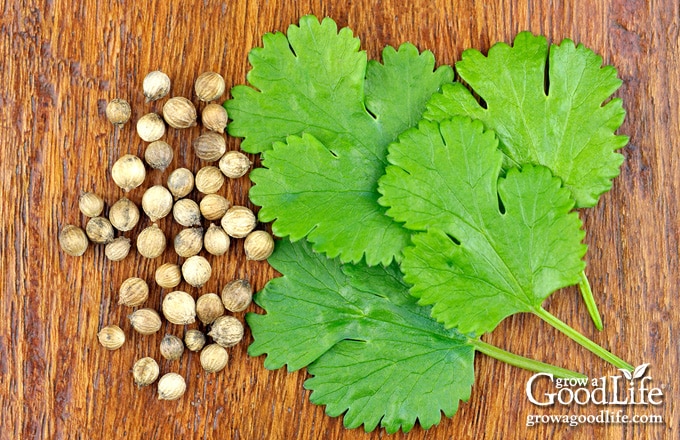
So, whether you’re a cilantro fan or not, there are plenty of reasons to grow it in your garden. In this guide, we’ll show you everything you need to know about growing cilantro at home, whether you’re planting it in a dedicated herb garden, as a companion to other crops, or in containers.
About Cilantro
Cilantro (Coriandrum sativum), also known as coriander or Chinese parsley, is an annual herb that is a member of the Apiaceae family, which also includes parsley, carrots, dill, and celery. It has delicate, lacy leaves and a distinctive aroma often described as citrusy or earthy.
Cilantro is native to regions of the Mediterranean and Asia, and North Africa. The herb has been used in cooking for thousands of years and has a rich history dating back to ancient civilizations such as the Greeks, Romans, and Egyptians.
The ancient Egyptians used cilantro in their embalming rituals, and the Romans used it as a seasoning for their food. In the Middle Ages, cilantro was prized for its medicinal properties and was used to treat digestive problems, as well as to mask unpleasant odors.
Today, cilantro is commonly used in many different cuisines, including Mexican, Indian, and Thai. Its bright, fresh flavor pairs well with a variety of dishes, from soups and stews to salads and salsas.
Common Types of Cilantro
There are several different types of cilantro that you can grow in your garden, both for foliage and seeds. Here are some varieties of cilantro to consider growing:
- Caribe cilantro is prized for its long stems and resistance to bolting, which means it can be harvested for a longer period of time.
- Long Standing Santo cilantro has dark green leaves with a slightly stronger flavor than other varieties. It is also slow to bolt, making it a good choice for those gardening in warmer climates.
- Leisure cilantro has thin stems and delicate leaves and is known for its slow bolting. It has a mild flavor that is not as pungent as some other varieties.
These are just a few of the many cilantro varieties available. When choosing a variety, consider the flavor, bolting time, and your growing conditions to find the best fit for your garden.
Tips for Growing Cilantro
When it comes to cilantro, it’s best to direct sow from seeds rather than purchasing transplants. The plants are incredibly sensitive to root disturbance, which can cause them to bolt prematurely after transplanting. Even the process of removing the seedling from its cell pack can trigger this issue, so it’s best to avoid it altogether.
I have successfully started seeds indoors using soil blocks, though. Planting the whole block eliminates the root disruption that can trigger the plants to go to seed.
However, if you’re not using soil blocks, it’s best to direct sow the seeds in your garden or container. This will help ensure a healthy and happy cilantro plant for all your culinary needs. Use these tips for successfully growing cilantro in your home garden:
When to Grow Cilantro
Cilantro is a cool-weather herb that likes temperatures between 50 to 85˚F. Planting in the spring or fall is ideal, as hot summer weather can cause it to bolt prematurely.
Direct sow seeds in spring after all danger of heavy frost has passed. Succession sow seeds every 3 weeks for a continuous harvest until the weather warms. Then begin sowing again in the fall. Established plants can handle light frosts, and you can extend your harvests by offering some frost protection.
Garden Selection and Soil Prep
Cilantro prefers full sun to partial shade and well-draining soil. So look for a spot in your garden with at least 6 hours of sunlight daily.
Before planting cilantro, prepare the garden bed by removing weeds and adding organic matter like finished compost to improve soil drainage and fertility. Cilantro is not picky about soil pH but needs well-draining soil to thrive.
How to Start Cilantro from Seed
Cilantro seeds are unique in that they are actually composed of two seeds contained in a husk, which is round and light brown in color. You can plant whole seeds or gently crush each seed to release the two seeds inside, which are flattened and ribbed.
- Soak the seeds: Before planting, soak cilantro seeds in water for 24 hours to soften the seed coat.
- Plant the seeds: Plant the seeds 1/4 inch deep in well-draining soil and water thoroughly. Space the seeds about 1 inch apart.
- Wait for germination: Cilantro seeds should germinate in 7 to 10 days.
- Thin the seedlings: Once the plants are about 2 inches tall, thin them to 6 inches apart to give them room to grow.
- Repeat: Start a new batch of seeds every 3 weeks to keep a steady supply of cilantro growing.
And remember, if you’re using soil blocks to start your cilantro seeds, you can plant the whole block in the garden to avoid disturbing the roots and triggering premature bolting.
Growing Cilantro in Containers
Growing cilantro in containers is a great option if you have limited space. You’ll need a container at least 6 inches deep with drainage holes in the bottom. Fill the container with a damp high-quality potting mix suitable for containers. You can learn more about growing crops in pots in this article: How to Grow a Container Garden.
Soak the cilantro seeds in water for a few hours, then sow the cilantro seeds 1/4 inch deep, about 1 inch apart, and water well. Find a sunny location for your container, keep the soil surface moist until the seeds sprout, and then reduce watering.
To ensure a continuous harvest, you can plant new containers of cilantro every 3 weeks. This will give you a fresh supply of cilantro leaves for your culinary creations.
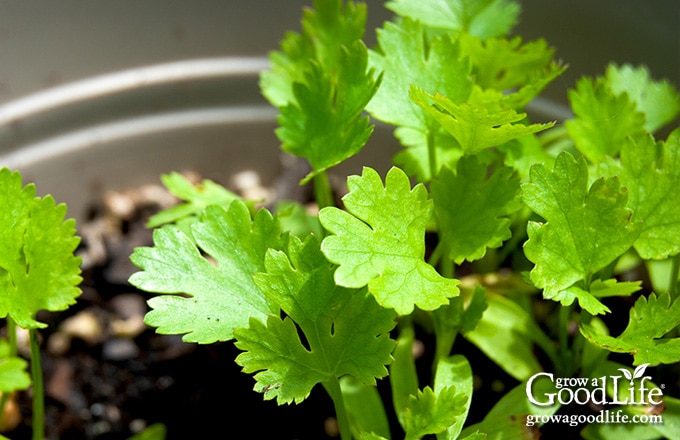
Cilantro as a Companion Plant
Cilantro is not only a delicious herb, but it also makes a great companion plant in the garden. When planted alongside certain vegetables like tomatoes, peppers, and cucumbers, cilantro can help to repel pests and attract bees and other beneficial insects.
The strong scent of cilantro can confuse pests like aphids and spider mites. The plant can also serve as a habitat for beneficial insects like ladybugs and lacewings, which can help control pest populations.
Additionally, planting cilantro under a tall plant like tomatoes can help to extend its growing season. Since cilantro is a cool-weather crop, it can struggle in the heat of summer. By planting it under a taller plant, the cilantro will be partially shaded from the sun, creating a cooler microclimate to help it thrive.
This is especially useful if you want to continue harvesting cilantro throughout the summer months for all your fresh salsas. Just be sure to plant cilantro where it still gets some sun, as it needs at least 6 hours of sunlight per day to grow properly.
How to Care for the Plants
Cilantro is a low-maintenance herb, but it still needs some care to ensure it stays healthy and produces well. Here are some tips for keeping your cilantro plants in good shape:
- Watering: Cilantro needs consistent moisture in the soil to thrive. Make sure to water the plants regularly, especially during dry spells. However, be careful not to overwater, as this can lead to root rot. A good rule of thumb is to water when the soil feels dry. Keeping the plants well-watered can also help prevent early bolting.
- Weeding: Weeds can compete with cilantro plants for nutrients and water, so keeping the area around the plants free of weeds is important.
- Mulching: Mulching around cilantro plants can help retain moisture in the soil and suppress weed growth. A layer of organic mulch, such as straw or shredded leaves, can be applied around the base of the plants. This can also help keep the soil cool, which is important for cilantro’s growth.
- Fertilizing: Cilantro doesn’t require a lot of fertilizer, but it can benefit from a balanced fertilizer every 4 to 6 weeks to encourage leafy green growth. You can use a slow-release granular fertilizer or a liquid fertilizer, following the instructions on the packaging. Avoid over-fertilizing, as this can lead to premature bolting.
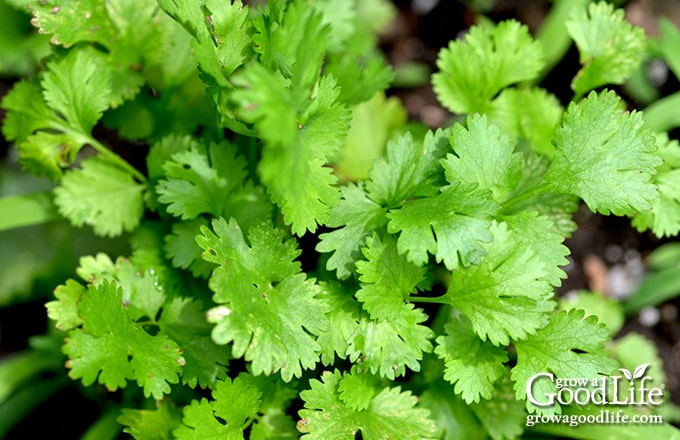
Pests and Diseases
Cilantro is one of the easiest herbs to grow, but like any plant, it can be vulnerable to pests and diseases. The good news is that with a little bit of attention and care, you can keep your cilantro plants healthy and thriving. Here are some common pests and diseases to keep an eye out for:
It’s important to note that in addition to attracting beneficial pollinators to the garden with its pollen-rich blooms, it can also attract pests like aphids, lacewings, and cabbage loopers. Watch for yellowing leaves or holes, as these are signs of a pest infestation.
Powdery mildew and leaf spot are two fungal diseases that can affect cilantro. Avoid overhead watering and ensure good air circulation around the plants to prevent these diseases.
In addition to pests, diseases such as Fusarium wilt and leaf spot can also affect cilantro. Improper watering often spreads these diseases, so it’s important to keep the soil moist but not too soggy and water at the root level. Wet leaves create a damp environment that pests and diseases love.
Preventing Cilantro from Bolting
Cilantro is a fast-growing herb that can bolt quickly, especially in hot weather. Bolting happens when a plant produces a flowering stem and goes to seed prematurely before reaching full maturity. When cilantro bolts, it grows tall with flowers and seeds, making the leaves less flavorful and bitter.
If you’re growing cilantro for coriander seeds, letting it bolt is necessary. However, if you want to keep your plants producing foliage longer, you can take a few steps to prevent bolting.
Planting slow-bolting varieties, providing partial shade, and keeping the roots cool and moist during hot spells can all help prevent premature bolting. You can also snip off flower stalks as soon as they appear. This allows the plant to channel its energy into foliage growth instead of seed production.
By following these tips, you can prolong your cilantro harvest and enjoy its fresh flavor in your dishes for longer.
Growing Coriander Seeds
Coriander seeds are produced when the cilantro plant is allowed to bolt. If you want coriander seeds, plant cilantro and just let it grow and go to seed. The plant will eventually develop a tall flower stalk and bloom. Once the flowers have turned into seeds, allow them to mature and dry on the plant.
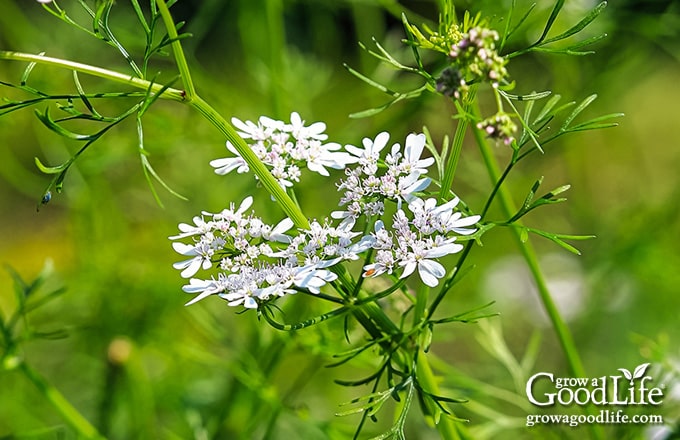
How to Harvest Cilantro
Harvesting cilantro leaves is easy. Use a sharp pair of scissors or garden shears to snip the leaves off at the base of the stem when they reach about 4 to 6 inches in length. Leave at least one-third of the plant intact to continue growing and producing new leaves.
Once you have a bunch of fresh cilantro, here are some delicious ways to use it:
- Fresh Salsa: Finely chop cilantro leaves and mix them with your favorite salsa ingredients. Some recipes to try include garden salsa, fresh corn salsa, roasted salsa verde, and grilled tomato salsa.
- Guacamole: Mashed avocados can be taken to the next level by adding chopped cilantro leaves, diced tomato, onion, lime juice, and salt for a delicious guacamole.
- Mexican Dishes: Add freshly harvested cilantro leaves to your favorite Mexican recipes for a burst of flavor. Try fajitas, chicken enchiladas, and tacos.
- Curry: Add a handful of chopped cilantro leaves to your favorite curry recipe for added flavor and freshness.
- Canning Recipes: Fresh cilantro can also be used in some canning recipes such as Roasted Tomato Salsa Verde, Tomato Jalapeno Salsa, and Zesty Salsa.
How to Harvest Coriander Seeds
Harvest coriander once the seeds have fully dried on the plant. Cut the flower stalk and place the seed heads in a paper bag. Shake the bag to release the seeds, which will fall to the bottom of the bag. Separate the seeds from the stems or debris, and then store the seeds in a jar.
Store the coriander seeds in an airtight container in a cool, dry place for best results. This will keep them fresh and flavorful for up to a year. Then, use the seeds whole or ground in various recipes, from adding depth to chili and other stews to creating unique pickling blends.

Ways to Preserve Cilantro
Cilantro is a fast-growing herb that is best enjoyed when fresh, but you can use a few methods to preserve the foliage for later use. Here are some ways to preserve cilantro:
- Freezing: Cilantro can be frozen for later use. Chop the leaves and stems, place them in an ice cube tray with a bit of water or olive oil, and freeze. Once frozen, transfer the cilantro cubes to a freezer bag and store them in the freezer.
- Drying: Drying cilantro is another simple preservation method. Tie a bundle of cilantro stems together with a string and hang it upside down in a dry, well-ventilated area to dry naturally, or use a food dehydrator. Once the leaves are completely dry, remove them from the stems and store them in an airtight container. You can learn more about dehydrating herbs in this article: How to Harvest and Dry Herbs for Storage.
With these methods, you can enjoy the flavor and aroma of cilantro even after the growing season has ended.
—
Growing cilantro is a fun and easy way to add fresh flavor to your meals. Whether you’re planting in the ground or in containers, cilantro can thrive with just a little bit of care and attention. Follow these tips for growing cilantro and enjoy fresh, flavorful herbs all season long! Happy Gardening!
Good planning is key to a successful vegetable garden
Whether you are new to growing your own food or have been growing a vegetable garden for years, you will benefit from some planning each year. You will find everything you need to organize and plan your vegetable garden in my PDF eBook, Grow a Good Life Guide to Planning Your Vegetable Garden.

[ad_2]
